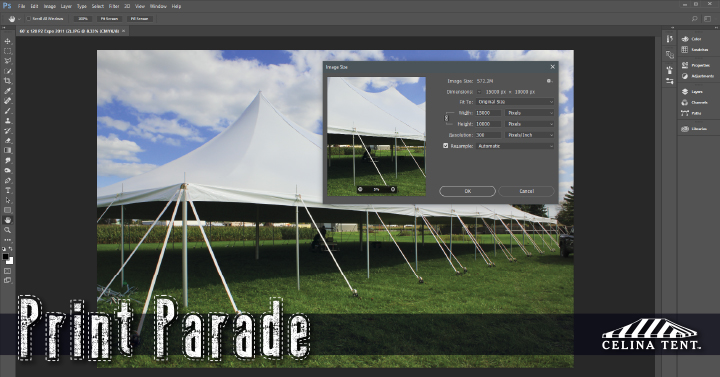Print Parade 2018 Good and Bad Images

Print Parade 2018: Is My Image a Good Image?
Welcome to Celina’s look at Ordering a Printed Product (wild applause, cheering from the balcony)! We’ll be covering all of the ins and outs of getting your branding from computer file to fabric to you. In order to make sure the process is as smooth as possible we’re going to break it down into three main categories: defining what a good image is, getting your image to us, and an explanation of artwork to template.
NOTE: Before dealing with the images needed for your print, be sure to place your order on GetTent.com. This secures your item’s spot in production, allowing us to schedule all of the manufacturing steps. With this in place we can begin manufacturing once the artwork has been arranged in a template and this template is approved by the customer.
File Info Breakdown
Whether you’ve decided to send us your artwork or are going to lay it out on our print templates yourself, the image that you’re working with will need to fit in with very specific criteria. The general guidelines are laid out in the printing section of our Knowledge Center, but include:
- Images are Vector Files
Vector files, the preferred file type for our printing processes, are images that are created with lines understood by the program as a series of points and equations. No matter how large or small the image is made, these points define where the lines and curves in the image are in relation to one another, allowing pristine definition across the size spectrum. The issue with vector files can be their size; with so much information they can become quite large.
- Images are acceptable Raster Files
A standard Raster File is any image created by a matrix of pixels (Picture + Element. Cool name, huh?). Because there is a unit limit to the sizing of the image (the unit being the single pixel), this means that raster images will start to look blurry or even blocky if blown up too much from the original size of the image. This can cause major problems for our imaging department, as we do try to make the best looking image for the finished product.
Any raster imagery needs to adhere to very specific ratios: 200 DPI at 100% Scale (300 DPI preferred). This means that when the image is opened at 100% scaling, the DPI (or dots per inch) is between 200 and 300. This gives the image enough dot density so that scaling won’t cause a large amount of image distortion. Most imaging software will have ways to check this.
- Image size isn’t too large or small
This is by far the easiest attribute to check – the size of your image file needs to be large enough (especially in the case of raster files) to look alright when applied, but not so large as to clog up or be rejected by our email or submission platform. Depending on how you intend to send your image, your file size limit can be from 10 Megabyte (MB – 1,048,576 bytes) to 1 Gigabyte (GB, 1,073,741,824 bytes).
Know Your Colors
The oddest part when considering the printed product of your choice is making sure the colors you choose are the colors you want. If you are looking for a specific color, it is imperative that you reference either a CMYK color formula (the mix of Cyan, Magenta, Yellow, and Black used by printers) or Pantone Solid Coated reference numbers (color matching system). Using either of these will let us know exactly what color to print for quality assurance purposes.
Please remember that when you look at certain colors on your computer monitor, they are most likely going to be different once the items is printed (due to how the colors are formed, either by light or by ink – covered in our artwork requirements video).
Whew! You made it through the first part of our series! If you have any additional questions about what makes an image acceptable, visit our Knowledge Center for our artwork guides or shoot us an email at Art@CelinaTent.com. Check back next week for our blog on different ways to send us your perfect image!
Visit our other Print Parade articles:
Print Parade 2018: How and Where Do I Send my Artwork?
Print Parade 2018: How Is the Artwork Set Up?

